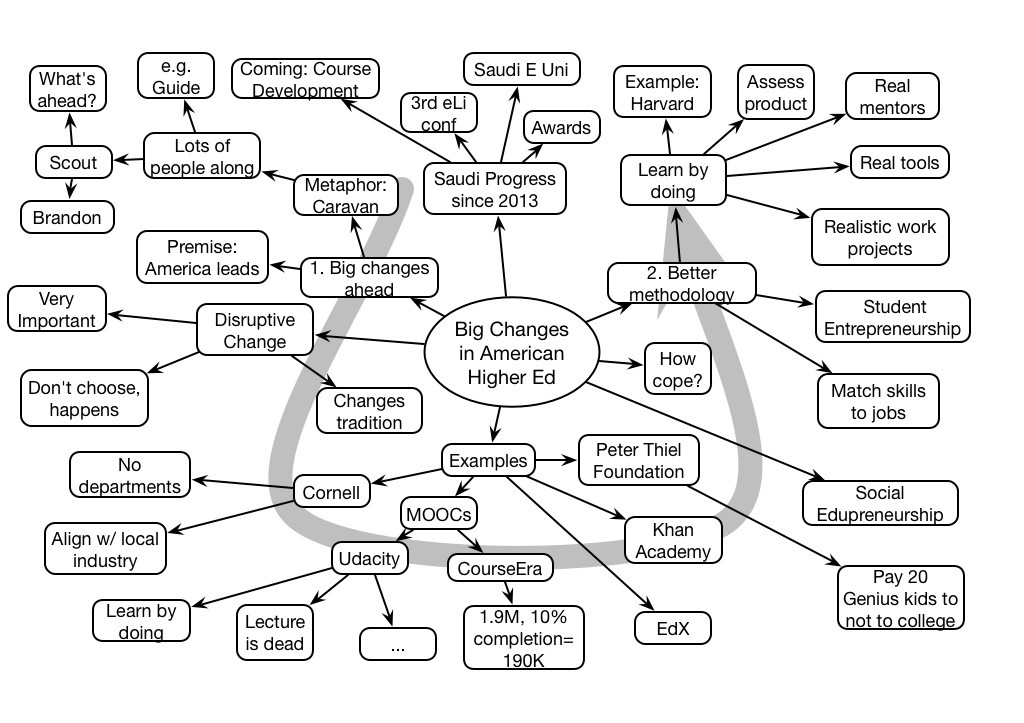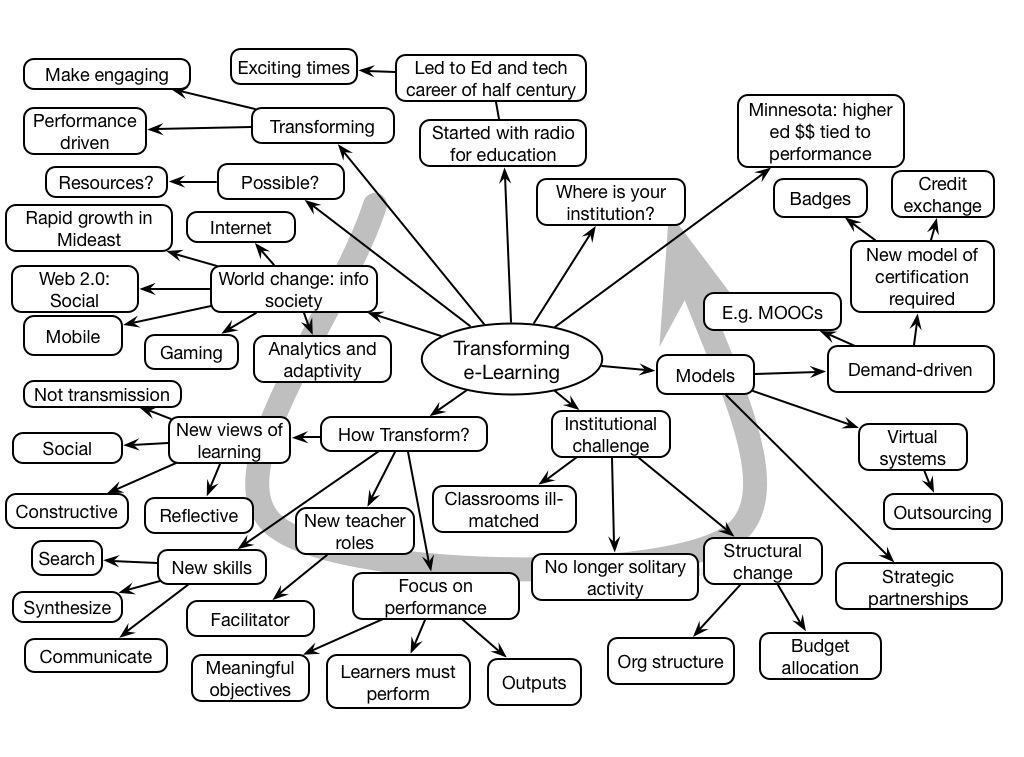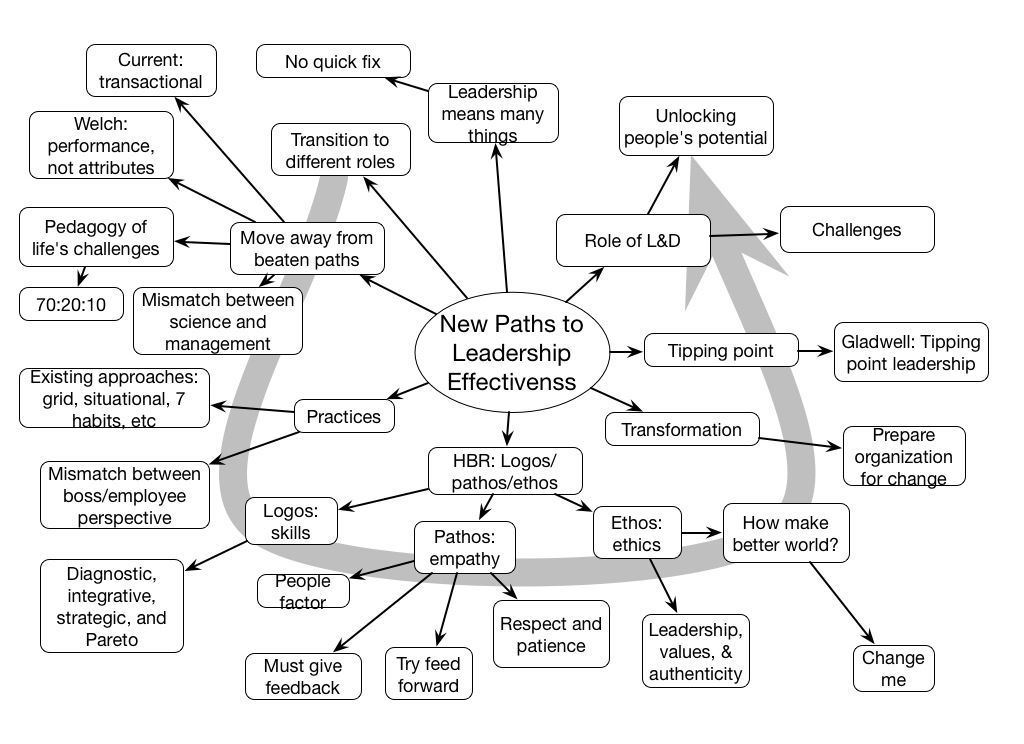Brandon Hall used the proposition that changes in the US are subsequently reflected in the rest of the world to examine coming changes in Higher Ed. He proposed that big change is coming and that the way to cope is to move to more vocational alignment and a project-based pedagogy.
Michael Moore #eli3 Keynote Mindmap
Steve Wozniak #eli3 Keynote Mindmap
The legendary Steve “The Woz” Wozniak was the opening keynote at the 3rd International Conference of e-Learning and Distance Learning. In a wide-ranging, engaging, and personal speech, Steve made a powerful plea for the value of the thoughtful learner and intrinsic motivation, project-based learning, social, and self-paced learning.
Living with Complexity
Don Norman (disclaimer, my PhD advisor and mentor) has had a string of important books, starting with his stellar Design of Everyday Things (tops my ‘recommended books’ list for designers). His latest, Living with Complexity, is not as landmark a book as that, but it has some very astute thinking to present.
The book, as the title implies, is largely about how complexity isn’t bad, it’s necessary, and the real issue is about designing to manage it. We want powerful systems to accomplish meaningful goals, and he makes the case that this naturally requires complexity, either at the front end or at the back end. Complexity at the front end offers powerful choice at the tradeoff of comprehensibility, which we often want. Complexity at the back end can seem like magic, but offers more opportunity for things to go wrong catastrophically.
Good design is naturally the solution. He suggests that good design makes complexity usable, and bad design makes complexity frustrating. And he makes a strong point that it’s now about services.
He goes beyond product design in detailing how you really aren’t designing just a product, but an experience, and that it takes a system to create an experience. Using Apple’s iPod, he points out how simplifying the purchasing (backend: lining up publishers to allow downloading individual titles for a simple fee) and downloading music (instead of converting files and storing in special folders) made a device that could carry a lot of music in a small package.
He goes deeper into service design, using the examples of waiting in lines (I now know why immigration in SFO can be so frustrating!). He finally gets to coverage of recommendations for improvements, including signifying (making affordances perceivable), checklists, and job aids (over courses). His focus is on tapping into how our minds work, and aligning tools with them. He covers both sides, including what designers should do differently, and what ‘consumers’ can do. He also covers some of the mismatches between design and consumers, going beyond the design to the overall system.
Overall, while seemingly not as well structured as previous books, this book offers some advanced thinking into design that will benefit those looking to take a bigger picture. Feeling more like a collection rather than a coherent narrative, each of the elements is related and there are important insights in each section. Recommended for the advanced designer.
Old -> New
My ITA Colleague Jay Cross had a hangout over the weekend and the conversation rolled around to the role of L&D in the new era (related to yesterday’s post). I’ve previously addressed how we can now be using tech for more of the full suite of performance, but it occurred to me that there are some ways we could and should be thinking differently about the ways in which performance can be supported. And while these old:new lists are fun and sometimes overdone, and these may have been covered elsewhere by others, it seemed reasonable to go through a few that occurred to me.
Courses -> Search
The first is that too often we think of courses, but what’s happening these days is that people are increasingly self-helping. Rather than take a course ‘just in case’, they’re getting the help they need ‘just in time’. It seems to me that we should be focusing on making sure that learners have good search skills, and searchable and well-organized portals, to ensure searching success. Whether you view it as performance support or a ‘teachable’ moment, the fact is that learners are self-serving, going for pull solutions more. The goal is to support performers how they want to, and are learning, rather than trying to force them into our models.
Instruction -> Coaching
As social media is more available, people are more available, and people are often reaching out to others for support rather than courses. Whether it’s a quick query through a microblog or a full blown video chat, people are increasingly reaching out to folks for help. This is similar to the courses/search above, but sometimes they go for content and sometimes for people. Are you making it easy to reach out to people?
Development -> Mentoring
Rather than developing people through programs, increasingly people are looking for mentoring. Programmed development is like taking the bus, when mentoring is like having a chauffeur. It may seem extravagant, but folks like to help, and increasingly having a program of ‘each one teach one’, where those who’ve benefitted from mentoring pass it on, is workable. With digital support, this becomes both a more momentary, and longer term activity. It’s increasingly viable, so it should be on your radar.
Read -> Watch
It used to be that to the only way to find things out was to read the manual, or a step-by-step job aid. That’s no longer true, and increasingly it’s easy to create videos that show how to do things. So, for example, it’s now easy to create software ‘walkthrus’, and it’s not just the L&D department that are creating them. Learners are getting them through services like Lynda.com, and creating their own with screen casting software. Not to say reading won’t continue to play a role for concepts, but for procedures, the context and dynamism makes videos powerful. Are you supporting video/screen cast creation, hosting, and searching?
Test -> Simulation
The pragmatic barriers to creating simulations are falling down, and we now know that knowledge test isn’t an adequate assessment of ability to apply. We no longer have to have separate summative assessments, as digital environments can store performance as part of a portfolio of ability. Most importantly, we can make the practice environment much closer to the performance environment. When we’ve determined a real skill needs to be developed, we can and should be looking at rich assessments of ability.
“’til they get it right” -> “’til they can’t get it wrong”
Coupled with the above is the notion that we can move from minimal practice that isn’t sufficient to develop capability and confidence, and start providing sufficient practice to ensure ability. We need to be spacing it out over time, and ensuring real competence, not just until folks have had a taste of it, but inadequate to develop real capability. If it matters, we need to match practice to task and learner, and we can.
Desktop -> Mobile
People are now going ‘mobile first’, as are companies like Google. The reality is that the mobile devices are more familiar, and more available. People are getting in the habit of getting their support through a mobile device. And enterprise platforms are increasingly making that solution available. Are you enabling your workers to meet their needs with mobile?
These are just a few ways we can, and should, be shifting our thinking. I’m sure you’ve got more, and I look forward to hearing them.
#itashare
Starting from scratch
From a conversation with my ITA colleagues, talking about the (self-imposed) death of L&D that Charles wrote about, Jane wondered what we might do if we were starting from scratch. I decided to take this on, thinking about an org that was already in operation, with it’s goals, processes, and practices, and what I might do if I were to come in and get it going (with the support of the executive team to do what I thought was right).
My initial step would be to establish a social media system, supporting conversations and collaboration on work teams and communities of practice. I’d make sure that folks could establish dialogs, work together on documents, and share files, quick pointers, and more fully developed thoughts. They’d also be able to both create and share media, video, audio, and screencasts. I’d want to have some folks supporting the development of the use of this capability, in a performance consulting or performance strategist role.
Associated with this would be a big emphasis on transparency in communication, with the overall mission of the org percolating all the way through, and emphasizing the part each role plays in the overall picture. Another emphasis would be on developing individual capability for self-learning.
My second step would be to set up a mechanism to support portals organized around work tasks (not by org silo), where media, files, and conversations around topics could happen. The goal is to have tools ‘to hand’ as well as people. Thus, any created job aids would be appropriately located. Again, with a performance strategy focus. This is related to the first point.
Finally, I’d consider formal learning to supplement the informal learning, in places where it demonstrably would add value, with a view to minimizing the use of this except where a sound business case could be made that the time spent was aligned to key business indicator, and that developing this skill was the necessary approach. And, perhaps, on ways to effectively take advantage of the systems indicated above. However, a longer term approach than the ‘event’ model would be used. I’d want to track activity, not just content and assessment. Compliance and onboarding, typically roles for formal learning, would have a different look than currently.
I’d supplement this with mobile access, and ultimately start looking for ways to add contextual support. I’d be looking for business impact across the board. I’d probably structure this as a performance unit, and ensure that the staff are trained to look at the full suite of opportunities to improve performance including social, and consider the emotional side – motivation, anxiety, and confidence – as well as the cognitive.
This is all hypothetical, of course, but I think it’s illustrative of a different way of approaching this. I think that the way things are going: changing faster, dealing with more ambiguity ,and requiring more ingenuity and innovation, require a different approach than the assess, prepare, rollout model. The focus increasingly is on supporting people meeting their needs, instead of attempting to meet their needs. Organizations have to be more nimble, and this approach starts there and works back, instead of the other way around.
#itashare
Dr. Palan #ASTDMENA Keynote Mindmap
At the ASTD Middle East North Africa event, Dr. Palan opened the second day by weaving a well-illustrated talk about how leadership is changing, moving from transactional to transformational.
ITA Predictions 2013
The Principals of the Internet Time Alliance decided to take a collective look ahead to the new year, and share our predictions. You‘ll see overlap but also unique perspectives:
Charles Jennings
 An increasing number of organisations, independent of size, nature or location, will acknowledge that their traditional training and development models and processes are failing to live up to the expectations of their leaders and workforce in a dynamic and global marketplace. Some will take steps to use their financial and people resources and exploit new ways of working and learning. Others will be hamstrung with outdated skills, tools and technologies, and will be too slow to adapt. A confluence of technology and improved connectivity, increasing pressures for rapid solutions and better customer service, and demands for higher performance, will force the hands of many HRDs and CLOs to refocus from models of ‘extended formal training‘ to place technology-enabled, workplace-focused and leader-led development approaches at the core of their provision. We will move a step or two closer to real-time performance support at the point of need.
An increasing number of organisations, independent of size, nature or location, will acknowledge that their traditional training and development models and processes are failing to live up to the expectations of their leaders and workforce in a dynamic and global marketplace. Some will take steps to use their financial and people resources and exploit new ways of working and learning. Others will be hamstrung with outdated skills, tools and technologies, and will be too slow to adapt. A confluence of technology and improved connectivity, increasing pressures for rapid solutions and better customer service, and demands for higher performance, will force the hands of many HRDs and CLOs to refocus from models of ‘extended formal training‘ to place technology-enabled, workplace-focused and leader-led development approaches at the core of their provision. We will move a step or two closer to real-time performance support at the point of need.
Clark Quinn
 We‘ll see an increasing use of mobile, and some organizations will recognize the platform that such devices provide to move the full suite of learning support (specifically performance support and informal learning) out to employees, dissolving the arbitrary boundaries between training and the full spectrum of possibilities. Others will try to cram courses onto phones, and continue to miss the bigger picture, increasing their irrelevance. Further, we‘ll see more examples of the notion of a ‘performance ecosystem‘ of resources aligned around individual needs and responsibilities, instead of organized around the providing silos. We‘ll also see more interactive and engaging examples of experience design, and yet such innovative approaches will continue to be reserved for the foresightful, while most will continue in the hidebound status quo. Finally, we‘ll see small starts in thinking semantic use in technology coupled with sound ethnographic methods to start providing just such smart support, but the efforts will continue to be embryonic.
We‘ll see an increasing use of mobile, and some organizations will recognize the platform that such devices provide to move the full suite of learning support (specifically performance support and informal learning) out to employees, dissolving the arbitrary boundaries between training and the full spectrum of possibilities. Others will try to cram courses onto phones, and continue to miss the bigger picture, increasing their irrelevance. Further, we‘ll see more examples of the notion of a ‘performance ecosystem‘ of resources aligned around individual needs and responsibilities, instead of organized around the providing silos. We‘ll also see more interactive and engaging examples of experience design, and yet such innovative approaches will continue to be reserved for the foresightful, while most will continue in the hidebound status quo. Finally, we‘ll see small starts in thinking semantic use in technology coupled with sound ethnographic methods to start providing just such smart support, but the efforts will continue to be embryonic.
Harold Jarche
 People who know nothing about connectivism or collaborative learning will profit from MOOC‘s. Academics and instructional designers will tell anyone who wants to listen just how important formal training is, as it fades in relevance to both learners and businesses.The ITA will keep on questioning the status quo and show how work is learning and learning is the work in the network era – some will listen, many will not.
People who know nothing about connectivism or collaborative learning will profit from MOOC‘s. Academics and instructional designers will tell anyone who wants to listen just how important formal training is, as it fades in relevance to both learners and businesses.The ITA will keep on questioning the status quo and show how work is learning and learning is the work in the network era – some will listen, many will not.
Jane Hart
 Many traditional-thinking organisations will waste a lot of time and energy trying to track social interventions in the hope that they can control and manage “social learningâ€. Whilst those organisations who appreciate that social learning is a natural and continuous part of working, will acknowledge that the most appropriate approach they can take is simply to support it in the workplace – both technologically and in terms of modelling new collaborative behaviours. Meanwhile, we will continue to see individuals and teams bypass IT and T&D departments and solve their learning and performance problems more quickly and easily using their own devices to access online resources, tools and networks.
Many traditional-thinking organisations will waste a lot of time and energy trying to track social interventions in the hope that they can control and manage “social learningâ€. Whilst those organisations who appreciate that social learning is a natural and continuous part of working, will acknowledge that the most appropriate approach they can take is simply to support it in the workplace – both technologically and in terms of modelling new collaborative behaviours. Meanwhile, we will continue to see individuals and teams bypass IT and T&D departments and solve their learning and performance problems more quickly and easily using their own devices to access online resources, tools and networks.
Jay Cross
 2013 will be a great year. As William Gibson wrote, “The future‘s already here. It‘s just not evenly distributed yet.†The business world will become a bit more complex — and therefore more chaotic and unpredictable. Moore‘s Law and exponential progress will continue to work their magic and speed things up. Learning will continue to converge with work. Increasingly, workers will learn their jobs by doing their jobs. The lessons of motivation (a la Dan Pink) and the importance of treating people like people will sink in. Smart companies will adopt radical management, putting the customer in charge and reorganizing work in small teams. Senior people will recognize that emotions drive people — and there are other emotions in addition to passion. Happy workers are more engaged, more productive, and more fulfilled. What‘s not to like?
2013 will be a great year. As William Gibson wrote, “The future‘s already here. It‘s just not evenly distributed yet.†The business world will become a bit more complex — and therefore more chaotic and unpredictable. Moore‘s Law and exponential progress will continue to work their magic and speed things up. Learning will continue to converge with work. Increasingly, workers will learn their jobs by doing their jobs. The lessons of motivation (a la Dan Pink) and the importance of treating people like people will sink in. Smart companies will adopt radical management, putting the customer in charge and reorganizing work in small teams. Senior people will recognize that emotions drive people — and there are other emotions in addition to passion. Happy workers are more engaged, more productive, and more fulfilled. What‘s not to like?
Thinking about thinking out loud
This past weekend, we were doing some home work, and I had occasion to go to the hardware store. Several. Several times. What’s interesting to me was two different interactions and the possible implications.
So, first I needed some paint. The guy I worked with was quite helpful, asking questions. (Somehow, he always seemed to be up selling, but that’s beside the point.) Actually, we ended up short on the quantity of paint, but we got paint we liked. What I didn’t get a sense of, however, was the underlying reasoning behind his questions.
In a non-comparable situation, we were having trouble installing some flooring. The click and lock wasn’t going quite fine. So, on the pursuit of a tool and some baseboards, I made an extra point of asking for help from the expert. He asked some diagnostic questions, and proceeded to explain what he thought our problem had to be. In this instance, I felt like I understood the process better.
So they’re not the same: in one case I’m buying product, and in another I’m troubleshooting. But what occurred to me is the opportunity here for thinking out loud to be a customer-benefit. You’ve seen or can imagine the situation where the newer hardware store employee, stymied by the question, tracks down the ‘oldie’ who knows everything and gets the answer. It’s often very helpful to the customer to hear the oldie talk in a way that educates the youngster as well as the customer.
We’ve been advocating the Coherent Organization, and as Jay Cross rightly points out, this extends beyond the organization to the extended enterprise. What struck me was what the opportunity might be if every consumer-facing employee in an organization was coached in effective ‘thinking out loud’. There’d be internal benefits, of course, in having the wisdom of the ‘oldies’ available to the newer members of the team. But the real upside, it seems to me, is in the benefit to the customer. For one, the trust that comes from a willingness to share. It’d be hard to do if the major compensation is commission, as you wouldn’t want to be sharing those thoughts (cue the ClueTrain), but certainly you could be talking about tradeoffs between solutions and clue in the customer on what’s important in the evaluation.
I know I’d be more likely to return to a store that helps me learn about the products. Solution selling could be more than just a methodology, in this case it could be a significant upskilling of the customer base (and employee base). It’s moving the social network back to conversation, away from the media channels, but it’s a significant augment. What do you think would be the benefit of coaching on ‘thinking out loud’ to not only internal employees but customer-facing ones?6
I’ve got your content right here
I was engaging in a mobile strategy session with a small not-for-profit the other day, and naturally it became an overall technology strategy session, as you really can’t do mobile strategy without considering social media strategy, learning technology strategy, even enterprise technology strategy. Mobile is a platform for all of the above, and you
One of the questions they struggled with was their social media strategy, as they were (as many people are) struggling with their existing workload. And there are lots of elements that can, and should, play a role. But their problem was really much simpler.
They had a Facebook page, and a twitter account, and a blog they had a placeholder for, and they couldn’t figure out how they were going to populate these. They were naturally concerned about what to blog, what to put on the Facebook page, what they would tweet about, and how they’d get the content for it, and keep it up.
The interesting thing was as we discussed it, talking about what a wide variety of material would make sense: reviews of relevant articles, updates about courses, etc, they started realizing that the content they needed was regularly being produced already. One enthusiastic staff member was always sending emails about things they should pay attention to. They also had notices about courses they were offering. And there was a regular stream of events that occurred.
It became clear that there was a lot of content available from their various channels, what they needed was curation. I was reminded of the fabulous job David Kelly does in curating conferences, and it’s largely the same set of skills (here’s Jane Hart interviewing Dave on the topic). Curation in many ways seems just an external manifestation of Harold Jarche’s Personal Knowledge Management (an extension of the share part of seek-sense-share).
It seemed plausible that they could give a few hours a week to a young person eager to add ‘social media’ to their resume who would do a minor bit of editing and get this to their blog. They wondered whether Facebook should have the same, and in this case the answer appeared to be ‘yes’ (blog allows RSS, some folks don’t go onto Facebook), and then the tweet stream could be for shorter pointers, announcements from the posts, whatever.
The result was that they had a simpler path to a coherent approach than they had realized. There’s more: it’s an org change and there’d have to be the usual messaging, incentives, etc. It’s only a start, but it gets them going while they develop the longer term strategy integrating mobile, web, social media, etc. Do you have a social media strategy in place, and is there emergent content from within your organization?



